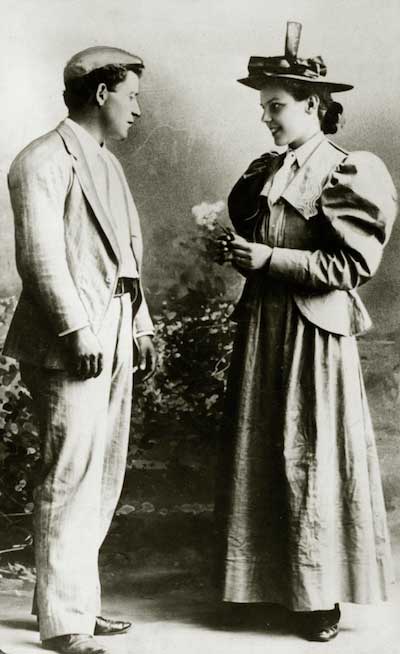Albion native married innovative coach who was influential in football’s popularity
“Overlooked Orleans” – Vol. 5, No. 2

University of Chicago Photographic Archive: Amos Alonzo Stagg and Stella Robertson Stagg are pictured as newlyweds, c. 1894.
Medina claims Frances Folsom Cleveland, an official First Lady of the United States of America, as her own and in 1952 apparently tried to claim the First Lady of American Football as well.
Henry Clune wrote in a September 16th edition of the Rochester Democrat & Chronicle that he “…expressed the opinion that the wife of the former famous University of Chicago coach, [Alonzo Stagg], had come from Medina.” Fred Tanner of Albion quickly pointed out that Clune was incorrect.
Another football season has passed and there is no playoff football for fans of the Buffalo Bills. Instead, I received a rather interesting message earlier this week highlighting an old newspaper clipping authored by County Historian Arden McAllister in the early 1970s. In this article, McAllister notes that he held in his possession “a picture of the Class of 1891 of Albion High School which includes a young woman he says may be perhaps the only unofficial woman football coach in history.” So instead of watching the Bills push for the Lombardi Trophy, a quick read about Orleans County’s connection to one of the greatest football pioneers will fill that void.
The story begins with Stella Robertson, the daughter of Peter and Mary Chester Robertson, born August 7, 1875 in Gaines. As an astute young woman, she was well regarded among members of her class, was selected as the vice president of her senior class and graduated from the Albion High School in 1891. She soon enrolled at the University of Chicago where she would meet Professor Amos Stagg.
Born on August 16, 1862, Stagg attended Yale College as a divinity student, earning quite the reputation as a pitcher for the Bulldogs’ baseball team and playing for the college’s 1888 undefeated football team. His career as a collegiate athlete earned him a dual appointment as “Associate Professor and Director of the Department of Physical Culture and Athletics with full tenure…a double precedent in the history of American higher education,” according to Robin Lester. Stagg became the first physical department head appointed with tenure and the first tenured appointment for an intercollegiate coach at any institution.
Compared to his elder colleagues, Stagg was strikingly young and perhaps less distinguished visually, but his career as an athlete earned him a degree of unprecedented respect. He quickly became the most eligible bachelor on campus and developed an open courtship with the young Stella Robertson of Albion. Faced with criticism from colleagues about his relationship with Robertson, Stagg contemplated a change of profession but remained in his position with the encouragement and support of his soon-to-be fiancée.
Arden McAllister wrote that “…[Stagg] once pedaled his bicycle all of the 30 miles to Gaines to keep a date with [Stella]” and that “He often played golf on a course that once existed at Eagle Harbor and walked across the farms in short pants and knee socks.” The couple’s wedding was performed by Rev. Osburn of the Baptist Church on September 10, 1894 at the Robertson home in Albion. Stella was nearly two years away from completing her studies at Chicago and the couple quickly returned to Illinois after the nuptials.
Alonzo Stagg, “The Grand Old Man of Football,” remained at the University of Chicago until 1932 when then university president Robert Hutchins forced the 70-year-old coach to retire. The couple relocated to Stockton, California where Stagg coached for the College of the Pacific until 1946. His lengthy coaching tenure ended at Stockton College after acting as the institution’s kicking coach; he was 96 when he retired.
Although the length of time Stagg spent coaching is quite impressive, it is his legacy that is the most remarkable. Knute Rockne, the legendary football coach of Notre Dame, once said, “All football comes from Stagg.” Rockne was later asked where he developed such innovative plays, to which he responded, “I took them from Stagg, and Stagg took them from God.” Such statements appear to be true, as Stagg is often credited with inventing the tackling dummy and developing the huddle, the reverse and man in motion plays, and lateral passes. He pioneered the forward pass, the place kick and initiated the use of uniform numbers as well as the awarding of varsity letters. His impact on sports extended beyond football, inventing the batting cage for baseball and promoting basketball as the 5-on-5 matchup played today.
Perhaps most important to Stagg’s innovative success was the role that his wife played in his career. A 1943 newspaper article notes that “Mrs. Stagg serves as scout, statistician, historian, typist and advisor, as well as a one-woman consolation committee whenever things are breaking tough.” McAllister also reaffirmed this by writing, “They say that Stella often helped her husband plot gridiron strategy.”
So, to conclude this article, the American Football Coaches Association presents the Amos Alonzo Stagg Award annually to the “individual, group, or institution whose services have been outstanding in the advancement of the best interests of football.” Marv Levy, the winningest coach in Buffalo Bills’ history, is set to receive the Amos Alonzo Stagg Award in 2019.










































































